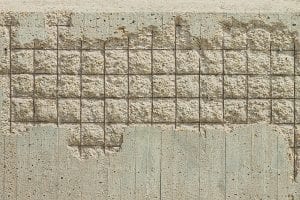If you’re wondering what that chalky white substance building up on your brick walls or outdoor pavers is, there’s a word for it: efflorescence.
It sounds pretty, but efflorescence is an ugly problem for building owners and managers. In a nutshell, efflorescence is a powdery white salt deposit that can crop up on masonry like brick, concrete, stone, and tiles.
Efflorescence: nice word, nasty problem
Minerals (like salts) are found naturally in materials like concrete and stone. Efflorescence is what happens when these minerals come in contact with excess water. When this occurs, the salts dissolve and leak out through pores in the masonry.
After the water evaporates, the salts remain and leave a white crust behind.
An example of when this can happen is if a concrete floor slab hasn’t been sealed properly during construction.
Following a heavy rainfall (like the flash floods we often see in South East Queensland), water can pool up. After this, salts can then leak through the substrate.
Once the water dries, the salts stay put and there you have it: efflorescence.
In French the word means “to flower out”. This term is actually a pretty good description of how salts seep through the surface of materials like bricks and concrete.
Why should you get on top of efflorescence
early?
While efflorescence isn’t technically a building defect, it’s a common issue for Core4’s Brisbane commercial building maintenance clients.
Efflorescence doesn’t just look bad. Left unchecked, it degrades exterior walls, makes tile surfaces slippery, and can be the sign of a chronic moisture problem. If it’s not treated in concrete, it can lead to the more serious issue of spalling – also known as “concrete cancer”.
What’s the best way to tackle efflorescence?
There are two main ways to remove the nasty white deposits: acid-based cleaners or abrasion.
1. Efflorescence can be dissolved with acid-based chemical solutions. You’ll find that specific products work best with different materials. With a wide range of acid cleaners available, it’s important to use a product suited to the affected surface.
2. Sandblasting is another option. For natural stone surfaces that don’t react well to acid, you can use a hand sander.
Traditionally, people have used abrasive methods to scour efflorescence away. These days however, chemicals are preferred because of being likely to damage surfaces.
Tips for smooth efflorescence removal
If you go with a popular acid-based cleaning method, follow these key steps.
1. Prep the affected area and surrounding space carefully.
2. Test the target area first. Apply the solution in a small, unobtrusive patch with a sponge or spray bottle. Scrub it in with a brush then rinse off lightly.
3. Don’t overuse water when you’re rinsing the solution. Remember moisture is what led to the problem in the first place.
4. Wait till the area is 100% dry before seeing if the cleaner worked. You might need to apply the product a couple of times to get rid of all the white rot.
5. Seal the surface to lessen the chance of efflorescence returning.
You’ll find YouTube videos like this example from Australia’s National Masonry firm that walk DIYers through the cleaning process. However, Core4 recommends working with professionals who know
- The best methods, products and equipment to use.
- How to test areas properly.
- How to diagnose tricky cases where efflorescence keeps recurring.
If efflorescence is a repeat offender, you will need to do some detective work to figure out what kind of moisture issue is making it come back. At this point, enlisting a specialist will definitely save you a lot of time, money and hassle.
Beat the pesky white buildup permanently
At Core4 we often say that prevention beats cure. When planning a new build, you can ward off or pre-empt efflorescence from happening, through using proper waterproofing, sealing and concreting techniques.
Your building’s street appeal and shelf life will keep longer if you have attractive, well-kept exteriors. If you let efflorescence run rampant, it simply undoes all your hard work making the rest of your building look great.
For quality, affordable help in battling the dreaded white buildup, contact Core4, your Brisbane commercial property maintenance experts now.

